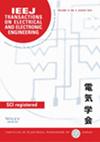求助PDF
{"title":"Surge Impact Characteristics of Low-Voltage Overhead Lines Caused by Natural Lightning","authors":"Xu Yan, Shaodong Chen, Min Ding, Chang Chen, Yijun Zhang, Lyuwen Chen","doi":"10.1002/tee.70010","DOIUrl":null,"url":null,"abstract":"<p>The paper presents an analysis of the residual voltage characteristics of surge protective devices (SPDs) made of zinc oxide on low-voltage overhead distribution lines. The study observed 65 natural lightning events and found that the geometric mean peak value of the SPDs' residual voltage was 767.6 V, with a geometric mean duration of 97.3 μs. The peak current flowing through the SPDs had a geometric mean of 6.4 A, and the SPDs absorbed an average of 0.2 J of energy. Based on the distinct processes of return stroke and the superimposed M component, the surge impacting the SPD can be categorized into three types. The currents flowing through type A and type B SPDs are essentially identical, but they differ in terms of residual voltage waveform. The main surge impact occurs during the return stroke process. Type C is distinct from the other two types: The surge impact expands through the superposition of the M component during the return stroke, resulting in approximately twice the duration of residual voltage and peak current flowing through the SPD compared to the other types. Additionally, in type C, the SPD absorbs about 5.8 times more energy. An analysis of the surge energy corresponding to the first and subsequent return strokes revealed that the surge energy generated by the first return stroke was approximately 2.5 times greater than that of the subsequent return stroke. © 2025 Institute of Electrical Engineers of Japan and Wiley Periodicals LLC.</p>","PeriodicalId":13435,"journal":{"name":"IEEJ Transactions on Electrical and Electronic Engineering","volume":"20 9","pages":"1350-1356"},"PeriodicalIF":1.1000,"publicationDate":"2025-03-12","publicationTypes":"Journal Article","fieldsOfStudy":null,"isOpenAccess":false,"openAccessPdf":"","citationCount":"0","resultStr":null,"platform":"Semanticscholar","paperid":null,"PeriodicalName":"IEEJ Transactions on Electrical and Electronic Engineering","FirstCategoryId":"5","ListUrlMain":"https://onlinelibrary.wiley.com/doi/10.1002/tee.70010","RegionNum":4,"RegionCategory":"工程技术","ArticlePicture":[],"TitleCN":null,"AbstractTextCN":null,"PMCID":null,"EPubDate":"","PubModel":"","JCR":"Q4","JCRName":"ENGINEERING, ELECTRICAL & ELECTRONIC","Score":null,"Total":0}
引用次数: 0
引用
批量引用
Abstract
The paper presents an analysis of the residual voltage characteristics of surge protective devices (SPDs) made of zinc oxide on low-voltage overhead distribution lines. The study observed 65 natural lightning events and found that the geometric mean peak value of the SPDs' residual voltage was 767.6 V, with a geometric mean duration of 97.3 μs. The peak current flowing through the SPDs had a geometric mean of 6.4 A, and the SPDs absorbed an average of 0.2 J of energy. Based on the distinct processes of return stroke and the superimposed M component, the surge impacting the SPD can be categorized into three types. The currents flowing through type A and type B SPDs are essentially identical, but they differ in terms of residual voltage waveform. The main surge impact occurs during the return stroke process. Type C is distinct from the other two types: The surge impact expands through the superposition of the M component during the return stroke, resulting in approximately twice the duration of residual voltage and peak current flowing through the SPD compared to the other types. Additionally, in type C, the SPD absorbs about 5.8 times more energy. An analysis of the surge energy corresponding to the first and subsequent return strokes revealed that the surge energy generated by the first return stroke was approximately 2.5 times greater than that of the subsequent return stroke. © 2025 Institute of Electrical Engineers of Japan and Wiley Periodicals LLC.
自然雷击对低压架空线路冲击特性的影响
分析了低压架空配电线路上氧化锌电涌保护装置的残余电压特性。通过对65个自然闪电事件的观测,发现spd残余电压的几何平均峰值为767.6 V,几何平均持续时间为97.3 μs。通过spd的峰值电流几何平均值为6.4 a, spd平均吸收0.2 J的能量。基于不同的回程过程和叠加的M分量,冲击SPD的喘振可分为三种类型。流过A型和B型spd的电流本质上是相同的,但它们在剩余电压波形方面有所不同。喘振冲击主要发生在回冲程过程中。C型与其他两种类型不同:浪涌冲击通过回程时M分量的叠加而扩大,导致通过SPD的剩余电压和峰值电流的持续时间大约是其他类型的两倍。此外,在C型中,SPD吸收大约5.8倍的能量。对第一次和随后的回击所对应的喘振能量的分析表明,第一次回击所产生的喘振能量大约是随后回击所产生的喘振能量的2.5倍。©2025日本电气工程师协会和Wiley期刊有限责任公司。
本文章由计算机程序翻译,如有差异,请以英文原文为准。

 求助内容:
求助内容: 应助结果提醒方式:
应助结果提醒方式:


